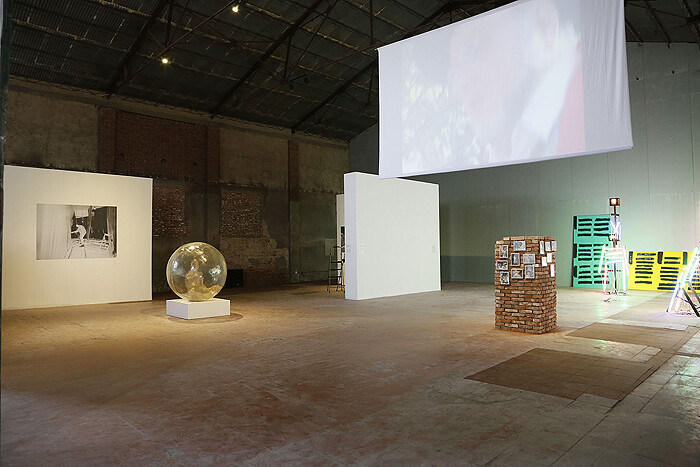In this inaugural exhibition in Star Gallery’s new Beijing space, curator Su Wei addresses certain perceived limitations in the discourse surrounding Chinese performance art. Drawing on the work of eight artists, the presentation avoids “formulated mechanisms,” Su writes, to specifically address works “irreducible to any classification within the historical process of aesthetics.” Su proposes that this can be partly accomplished by more fully addressing the original contexts of the performances: “It is impossible to [remove] the work of the artist from its site.”
Artists Ma Liuming, Zhu Ming, and Xing Danwen were part of the “East Village” community in Beijing in the early 1990s, known for body-art practices (i.e., Ma Liuming cooking naked in his studio’s courtyard) that would eventually lead to the scene being prematurely “shut down” by the police. In this show Ma is represented by documentation of his performance during a visit by British artists Gilbert & George to his studio in 1993 in which he stripped off his shirt and cut into a bag of red ink hidden in the ceiling, which poured down over his body like blood. Video documentation of a performance at the Istanbul Biennale from 2001 is also on view here, for which he reprised his role of “Fen-Ma Liuming” (the Chinese “Fen,” meaning perfume or fragrance, lends a gender-bending twist to the artist’s name), a personage that plays on Ma’s androgynous looks. Where Ma grapples with gender issues, Zhu Ming deals with actions of the body in limited spaces, often performing in an inflated bubble that clearly defines his room to move—and available air. In this show, a sculptural version of one of these plastic bubbles contains a dimly visible cross-legged human figure as a one-to-one souvenir, so to speak, of his performances.
Xing Danwen is well known for her series of photographs documenting the East Village artists. This exhibition displays a set of small prints capturing glimpses of their lives and performances, mounted on a roughly built brick column, perhaps reflecting the squalid conditions in which they lived. The ongoing debate in China over the status of these photographs as either documentation of artists’ work or as an original artwork by the photographer is resolved in this exhibition by not crediting the photographer’s subjects in any way.
Highlighting aspects of futility in the practice of art, Chen Shaoxiong revives two works from his early career, 72.5 hours of Electricity Consumption (1992) and Seven-day Silence (1991), the latter documenting the artist’s hushed week painting a series of plastic sheets in mournful black, while the former is a playful set of anthropomorphic metal structures with fluorescent lights linked to electricity meters recording their energy consumption over the allotted time. Chen Shaoxiong’s sometime-collaborator Liu Ding is also featured here with a performance video that focuses on confusing professional roles in the art world in a performative fashion. Here the artist performs as the character “Mr. Liu” (not himself) in a three-way dialogue with two curators, Marko Daniel (of the Tate Modern) and Carol Yinghua Lu (coincidentally also the artist’s wife). Absenting the figure of the artist—the ostensible subject of said discussion—Liu Ding finds himself in the surprising position of being able to provide third-party responses to questions regarding his own artistic practice (I Simply Appear in the Company of…, 2012).
The younger artists in this show, those born in the 1980s—Chen Zhou, Li Qi, and Li Ran—also use performance to set up problematic relations between the real and the fictional. Li Ran, in particular, has made a habit of constructing fictional cultural identities that he acts out in gallery performances or pseudo-documentary videos whose aesthetic would not be out of place on the History Channel. However, for the opening we saw him speaking as himself on the subject of how we look at ourselves within the art industry (Stop Imagining, 2013). The performance aspect of Chen Zhou’s piece, however, is left ambiguous: is the artist creating a fictional subject through this video? Or is this a real document of the subject? Chen’s subject is his friend and fellow artist Yu Honglei. Yu is presented in a tender video as a somewhat melancholy young man leafing through photos of himself as a punkish youth (My Loving Artist Yu Honglei, 2012), but the aims and meanings of this work in the context of this exhibition are difficult to pin down. In a more straightforward fashion, artist Li Qi pitches expertise against amateurism in Manual of Controlled Action—Wrestling Course (2012) in which the artist continually intervenes in a professional wrestler’s demonstration of moves with off-screen commands and suggestions, which subvert and discomfort the expert rather than assisting in any way; and in Biography of Li Xiushi (2013) the artist revisits his childhood attempts at putting on art shows, with a cast of friends providing fictional background and commentary.
While Su presents us with a strong set of works, the way in which they are “problematic” to aesthetic systems ultimately lacks sufficient explanation. Su’s curatorial vision for this exhibition can be seen to extend the critical approach that he and his colleagues Carol Yinghua Lu and Liu Ding (also an artist in the show) have initiated over the past few years. In particular, they have been tackling the thorny question of the place of the individual artist versus the collective (particularly complex within the specific Chinese context), and engaging in a reassessment of works previously dismissed as minor within particular artists’ oeuvres. Despite its flaws, “I’m Not Involved in Aesthetic Progress” productively adds to this process, highlighting works from a set of artists over several generations that deserve this rare opportunity for more sustained critical attention.











